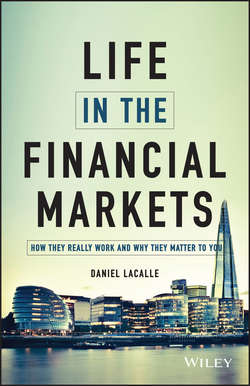Life in the Financial Markets

Реклама. ООО «ЛитРес», ИНН: 7719571260.
Оглавление
Lacalle Daniel. Life in the Financial Markets
Preface
Acknowledgements
Part I. The financial markets: Who they are, what they are, how they work
Chapter One “Thinking against the box”
Chapter Two. The financial market: Complex and volatile
An enlightening crisis and a real shock
Chapter Three. Welcome to London
Valuation models
Chapter Four. The market doesn't attack, it defends itself
Chapter Five. The Lehman crisis and the change in mentality: Habits and customs
Chapter Six. Traders, “robots” and speculators
“Robots” and how the markets are adapting to a changing environment
The commodities and oil market
Part II. The debt crisis and the great lie of free money
Chapter Seven. The debt market
Chapter Eight. Welcome, investors!
Chapter Nine. The European and sovereign debt crises
Chapter Ten. Credit-rating agencies
Chapter Eleven. When the problem only seemed to be Greece
Chapter Twelve. Why was the break-up of the euro feared?
Chapter Thirteen. Evil speculators: Someone else is to blame
Credit default swaps
Chapter Fourteen. Snowballing debt
Chapter Fifteen. The damned risk premium
What is the risk premium?
Chapter Sixteen. Derivatives: Weapons of mass destruction?
How long have derivatives been around?
What are they used for?
Purpose and uses of derivatives
Chapter Seventeen. The illusion of easy money: The investment banks and the great deception
Chapter Eighteen. Stimulus policies and kicking the can down the road
The impact of quantitative easing in emerging markets
Chapter Nineteen. Lies and mistakes of the debt crisis
Eight myths about the crisis
Bitcoin: Free currency, bubble or Ponzi scheme?
Ten myths about tax havens
Chapter Twenty. Economic liberty and austerity
Austerity and growth
Part III. Hedge funds and the stock market
Chapter Twenty-One. Hedge funds: The bad guys of the economic crisis?
Chapter Twenty-Two. Active management
Chapter Twenty-Three. Critics and reality
Chapter Twenty-Four. Strategies
Chapter Twenty-Five. Building portfolios
Portfolio vs. index
Chapter Twenty-Six. Closeness makes the heart grow fonder: How to identify investment opportunities
Investment process
Chapter Twenty-Seven. Short positions in a portfolio
Chapter Twenty-Eight. Banning short selling and the Tobin tax
Chapter Twenty-Nine. Recommendations
Watch out for consensus and crowded trades
Beware following government messages
Pay attention to the cost of capital
In a bear market the investor is never conservative enough
Be careful of dividends
Chapter Thirty. The long-term illusion… and the opportunity of value investing
Value investing: All is well that starts well
Good liquidity
Low leverage
High gross margins
A profitable business
Qualitative factors
Looking for good entry points
Chapter Thirty-One. A strange case: Companies with politicians
My favourite “shorts”
Chapter Thirty-Two. Communication with the market and attractiveness to investors
Chapter Thirty-Three. Why invest in a hedge fund?
Chapter Thirty-Four. Ten golden rules for investing
Chapter Thirty-Five “Warning” phrases and comments
Chapter Thirty-Six. Books and films about the market
Chapter Thirty-Seven. A day in the life of an investment fund
Chapter Thirty-Eight. Farewell
Euro-crisis and “exceptions”
Cyprus: Another “exceptional” episode in the European crisis
The contagion effect
What may happen in Spain?
Recommended Reading
WILEY END USER LICENSE AGREEMENT
Отрывок из книги
In this book, I begin by trying to show the human side of the markets and the day-to-day joys and difficulties that they produce. Then I offer my general take on the economy and its crises and, lastly, provide a technical analysis of investing in the stock market based on my experiences as an investor.
It has been an immense pleasure for me to draw together several years of ideas, observations and analysis in a work that I hope the reader will find enlightening and to their liking.
.....
Yes, the European financial crisis is not a crisis of deregulation or private banks; 50 % of European financial institutions were semi state-owned or controlled by politicians in 2006. There have been thousands of pages of regulations published every year since the creation of the European Union and the European Banking Authority (EBA). Regulation and supervision in Europe is enormous. Since 1999 and based on documents produced by the EBA, EU and European Central Bank (ECB), that's 180 new rules a week.
And as I will come on to argue, the crisis was born of an economic model too dependent on commercial banks with total assets that exceeded 320 % of the eurozone's combined gross domestic product (GDP) within a deeply integrated system. Excessive, complex and bureaucratic regulation has prolonged the agony of the industry for many years, instead of facilitating market conditions for the capital increases and asset sales needed.
.....